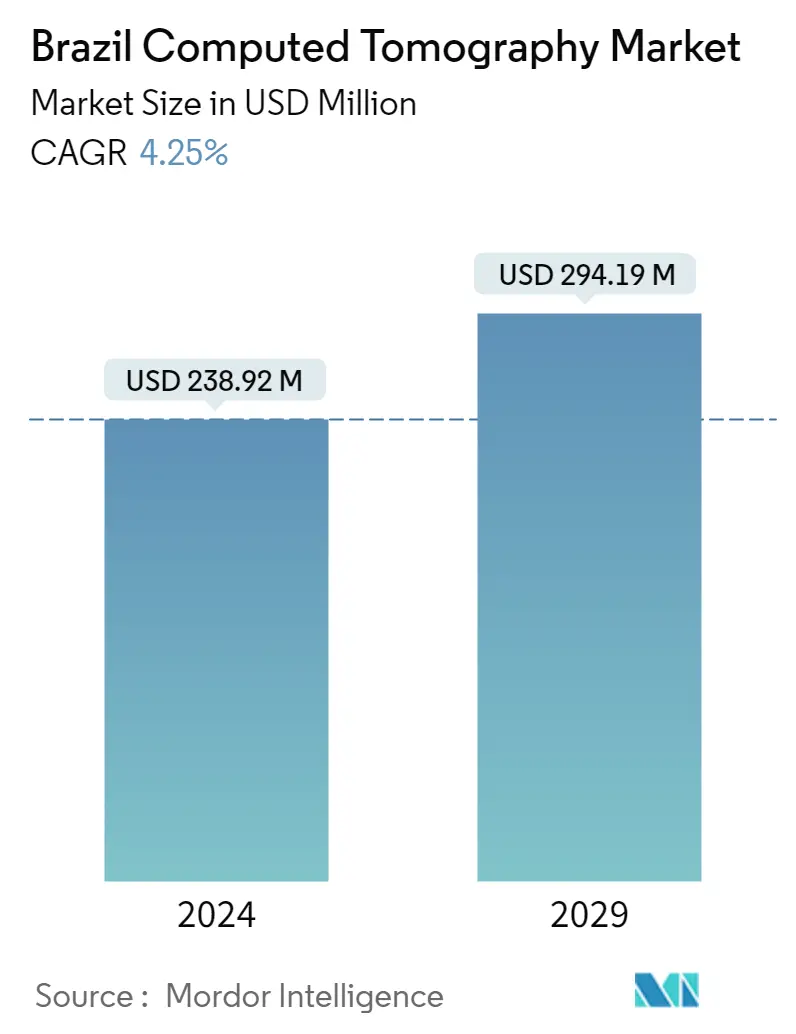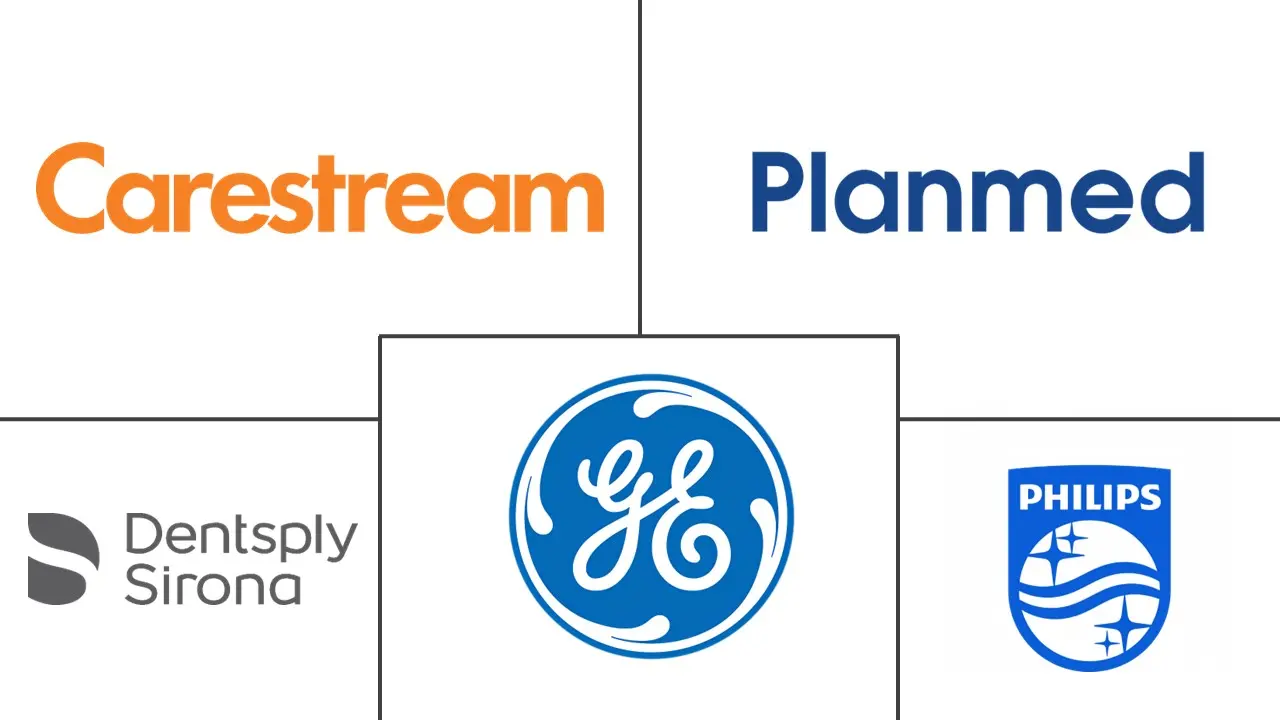Market Size of Brazil Computed Tomography Industry

| Study Period | 2019 - 2029 |
| Base Year For Estimation | 2023 |
| Market Size (2024) | USD 238.92 Million |
| Market Size (2029) | USD 294.19 Million |
| CAGR (2024 - 2029) | 4.25 % |
| Market Concentration | Medium |
Major Players
*Disclaimer: Major Players sorted in no particular order |
Brazil Computed Tomography Market Analysis
The Brazil Computed Tomography Market size is estimated at USD 238.92 million in 2024, and is expected to reach USD 294.19 million by 2029, growing at a CAGR of 4.25% during the forecast period (2024-2029).
The pandemic had an adverse effect on the country. Cancer patients were particularly affected by these activities since the length of time needed for screens, diagnoses, and treatment beginning had a negative impact on outcomes. Additionally, it was stated by the Brazilian National Health Agency (Agência Nacional de Sade - ANS) that non-urgent procedures, examinations, and visits will be postponed in 2020. In Brazil as a whole, screening services are significantly impacted by this. The national government of Brazil responded to COVID-19 by declaring a state of emergency due to the rise in cases, but the lockdown was implemented state-by-state, according to the research report "COVID-19: maintaining essential rehabilitation services across the care continuum" published in BMJ Global Health in May 2020. As a result, healthcare facilities all over Brazil provided inconsistent services. All outpatient facilities and services were shut down entirely in several states.
Numerous research studies have been released to offer light on the pandemic's effects. For instance, computed tomography (CT) was used to assess COVID in the nation, according to a research report published in July 2020 with the title "Computed tomography findings in a Brazilian cohort of 48 patients with pneumonia owing to coronavirus disease." Similar to this, a study with the title "Clinical usefulness of tomographic standards for COVID-19 pneumonia diagnosis: Experience from a Brazilian reference centre" was published in October 2020 at the Universidade Federal do Rio Grande do Sul, Program in Pneumology Sciences, Porto Alegre, RS, Brazil. In the early stages of the Brazilian COVID-19 outbreak, the study assessed the sensitivity, specificity, accuracy, and reproducibility of chest CT standards. A 16-slice CT was used for the chest CT, and patients were placed in the supine position during end-inspiration without receiving any contrast agent. Therefore, these studies would help the market grow. Thus, the market is expected to grow in the future.
Brazilian chronic disease occurrences, particularly those linked to neurological disorders and other chronic diseases, are a major driver of the computed tomography market. The growing research and development activity in the nation also influences its market. Parkinson's disease patients had an average age of 64.51 9.20 years, according to a study titled "Parkinson Anxiety Scale: A Validation Study for the Brazilian Population" published in 2020. This condition clearly illustrates that the rise in the geriatric population will lead to an increase in Parkinson's cases, and as a result, the studied market is anticipated to grow over the forecast period. Additionally, nearly 16% of all radiologists reported that CT imaging was their primary imaging technique, per a study titled "Estimating the productivity of radiologists in Brazil: the search for a benchmark," which was published in April 2020. This suggests that CT-related diagnostic techniques are becoming more prevalent across the nation. Collaboration is another key factor in market growth. In order to assess the safety, tolerability, and effectiveness of intranasal Foralumab in hospitalised patients with severe COVID-19 and pulmonary inflammation, Tiziana Life Sciences plc and FHI Clinical will perform a Phase 2 proof-of-concept trial in Brazil in September 2021. Following 14 days of intranasal delivery, the trial will assess the impact of foralumab on the remission of symptoms by chest computed tomography, inflammatory biomarkers, T-cell subpopulations, safety, and mucosal inflammatory response. Therefore, throughout the projection period, market expansion would be driven by the country's growing use of CT scanners in research and development. Thus, due to abovementioned factors the market is expected to grow in the future.
However, the lack of proper reimbursement and stringent regulatory approval procedures, and the high cost of equipment and CT scan procedures, are expected to hinder the market growth.
Brazil Computed Tomography Industry Segmentation
As per the scope of the report, computed tomography (CT) is an imaging process that customizes special X-ray equipment to generate a sequence of exhaustive images or scans of areas inside the body. It is also called computerized axial tomography (CAT) scanning, primarily used in cancer diagnosis. Brazil Computed Tomography Market is segmented by Type (Low Slice, Medium Slice, and High Slice), Application (Oncology, Neurology, Cardiovascular, Musculoskeletal, and Other Applications), and End User (Hospitals, Diagnostic Centers, and Other End Users). The report offers the value (in USD million) for the above segments.
| By Type | |
| Low Slice | |
| Medium Slice | |
| High Slice |
| By Application | |
| Oncology | |
| Neurology | |
| Cardiovascular | |
| Musculoskeletal | |
| Other Applications |
| By End User | |
| Hospitals | |
| Diagnostic Centers | |
| Other End Users |
Brazil Computed Tomography Market Size Summary
The Brazil computed tomography market is poised for growth, driven by an increasing prevalence of chronic diseases, particularly neurological disorders, and a rising geriatric population. The market's expansion is further supported by the growing research and development activities within the country, which are enhancing the application of CT scanners in various medical fields. The COVID-19 pandemic, despite its initial adverse effects on healthcare services, has also contributed to the market's growth by highlighting the importance of CT imaging in diagnosing and managing the disease. Studies conducted during the pandemic have underscored the utility of CT scans, thereby fostering advancements in imaging technologies and methodologies. Additionally, collaborations and clinical trials, such as those involving Tiziana Life Sciences plc, are expected to bolster the market by exploring innovative applications of CT imaging in clinical settings.
However, the market faces challenges such as high equipment costs, stringent regulatory approvals, and inadequate reimbursement policies, which could impede its growth trajectory. Despite these hurdles, the increasing incidence of cancer and the role of CT scans in cancer diagnosis are significant factors driving market expansion. The presence of major players like Carestream Health, GE Healthcare, and Koninklijke Philips NV, along with strategic partnerships and technological advancements, are expected to sustain the market's competitive landscape. Initiatives such as the introduction of mobile stroke CT scanners and local production agreements further illustrate the dynamic nature of the market. As Brazil continues to enhance its healthcare infrastructure and diagnostic capabilities, the computed tomography market is anticipated to experience substantial growth over the forecast period.
Brazil Computed Tomography Market Size - Table of Contents
-
1. MARKET DYNAMICS
-
1.1 Market Overview
-
1.2 Market Drivers
-
1.2.1 Increasing Prevalence of Chronic Diseases
-
1.2.2 Rising Geriatric Population
-
1.2.3 Increasing Technological Advancements
-
-
1.3 Market Restraints
-
1.3.1 Lack Of Proper Reimbursement And Stringent Regulatory Approval Procedures
-
1.3.2 High Cost of Equipment
-
-
1.4 Porter's Five Force Analysis
-
1.4.1 Threat of New Entrants
-
1.4.2 Bargaining Power of Buyers/Consumers
-
1.4.3 Bargaining Power of Suppliers
-
1.4.4 Threat of Substitute Products
-
1.4.5 Intensity of Competitive Rivalry
-
-
-
2. MARKET SEGMENTATION (Market Size by Value - USD million)
-
2.1 By Type
-
2.1.1 Low Slice
-
2.1.2 Medium Slice
-
2.1.3 High Slice
-
-
2.2 By Application
-
2.2.1 Oncology
-
2.2.2 Neurology
-
2.2.3 Cardiovascular
-
2.2.4 Musculoskeletal
-
2.2.5 Other Applications
-
-
2.3 By End User
-
2.3.1 Hospitals
-
2.3.2 Diagnostic Centers
-
2.3.3 Other End Users
-
-
Brazil Computed Tomography Market Size FAQs
How big is the Brazil Computed Tomography Market?
The Brazil Computed Tomography Market size is expected to reach USD 238.92 million in 2024 and grow at a CAGR of 4.25% to reach USD 294.19 million by 2029.
What is the current Brazil Computed Tomography Market size?
In 2024, the Brazil Computed Tomography Market size is expected to reach USD 238.92 million.

